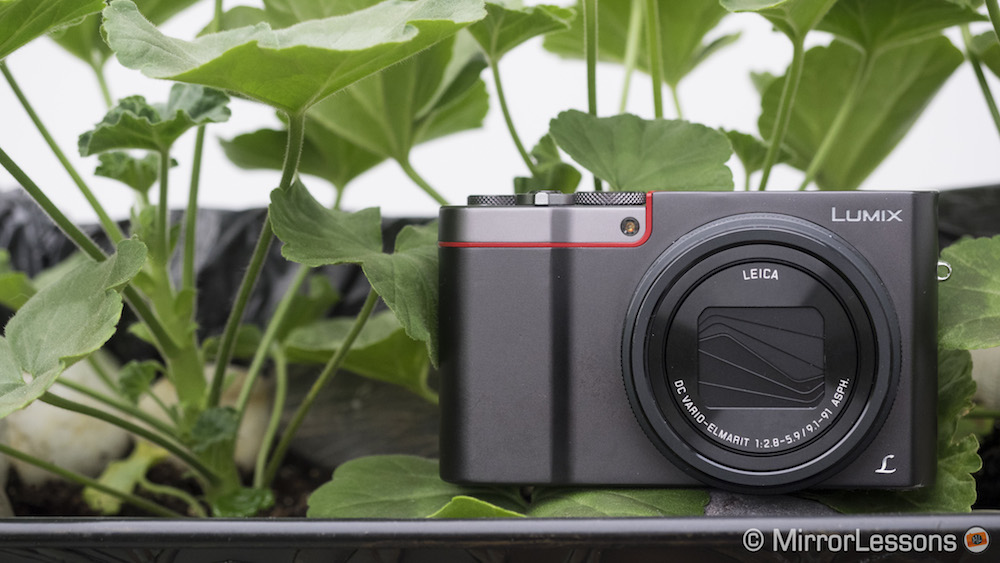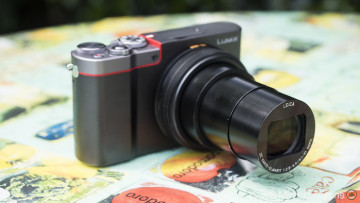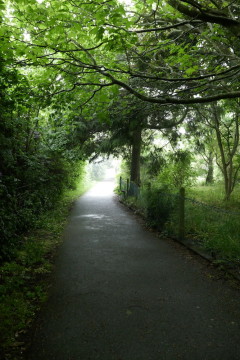The other week, Mathieu and I took a four-day trip up to the Lake District to take advantage of the unusually good British weather and indulge in some landscape photography. For a trip like this, I normally would have brought an interchangeable lens camera and a few lenses, but this time around I wanted a change, so I grabbed Panasonic’s premium travel zoom compact camera, the Panasonic Lumix TZ100 (otherwise known as ZS100 in the USA).
The Panasonic TZ100 is the first in the TZ series to house a large 1-inch sensor. It comes with an excellent zoom range (10x), is very small and perfectly pocketable, making it an appealing option for those wanting to travel light.
[toc heading_levels=”3″]
What I like the most – Size, weight and design
It hit me whilst climbing up Loughrigg Fell just how much I enjoyed carrying and using a camera the size of the TZ100, which is only 310g in weight and 110.5 x 64.5 x 44.3 mm in size. Mathieu felt the same way about the Sony RX100 II when we tested it a few years back in Wales. Not having to worry about changing lenses or carrying heavy bags allowed the image making process to take precedence. It was a refreshing change from the norm! 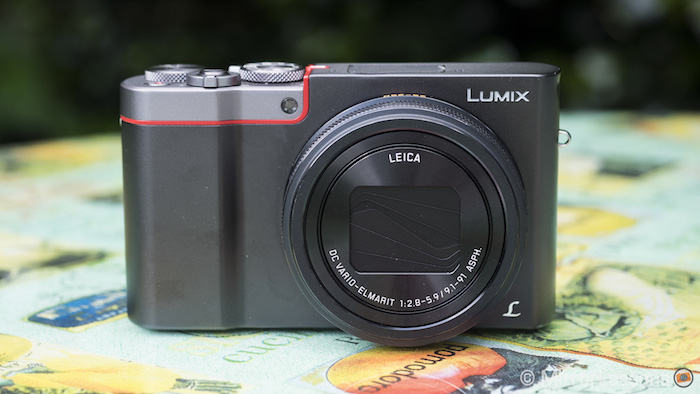 The camera has a metal shell that comes in either pure black or a combination of black and silver. On the latter, there is a stylish red band that separates the black and silver sections of the camera. It seems fairly robust but isn’t immune to damage. In fact, the copy we received to review already had a fairly large dent on top, so it must have suffered a nasty fall.
The camera has a metal shell that comes in either pure black or a combination of black and silver. On the latter, there is a stylish red band that separates the black and silver sections of the camera. It seems fairly robust but isn’t immune to damage. In fact, the copy we received to review already had a fairly large dent on top, so it must have suffered a nasty fall. 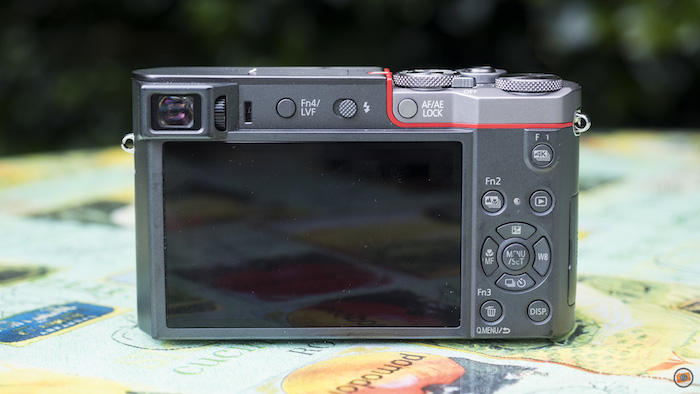 The body lacks a proper grip but the indent for your fingers on the front is more than sufficient. Since nearly all the buttons and dials are positioned on the right-hand side of the camera, you can easily use the camera with one hand. These buttons and dials include:
The body lacks a proper grip but the indent for your fingers on the front is more than sufficient. Since nearly all the buttons and dials are positioned on the right-hand side of the camera, you can easily use the camera with one hand. These buttons and dials include:
- a PSAM mode dial with iAuto, Art, Scene, Panorama, Custom and Movie options
- an on/off switch
- shutter release button surrounded by a zoom toggle
- a second dial to change shutter speed / aperture depending on the mode you’re in
- a customisable ring around the lens
- four physical and five virtual customisable function buttons
The customisable ring in particular is a very appealing addition because it gives you immediate access to a range of functions. For example, I have it set to Exposure Compensation because I often work in aperture or shutter priority. 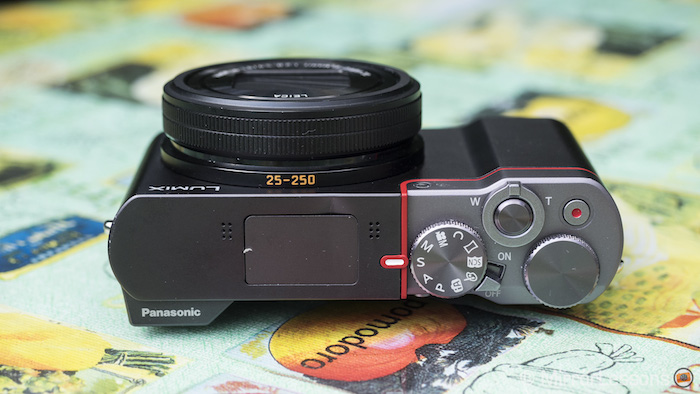 Despite its diminutive size, the TZ100 comes with a built-in flash, a built-in electronic viewfinder and a touch sensitive LCD screen. I’ll discuss the last two features in more detail later on.
Despite its diminutive size, the TZ100 comes with a built-in flash, a built-in electronic viewfinder and a touch sensitive LCD screen. I’ll discuss the last two features in more detail later on.
What I like – The zoom
- Leica DC Vario-Elmarit 9.1-91mm f/2.8-5.9
- 10x zoom range
- 25-250mm focal length range (35mm format equivalent)
- 12 elements in 10 groups
The Leica DC Vario-Elmarit 9.1-91mm f/2.8-5.9 zoom is definitely the star feature of the Panasonic TZ100. With an equivalent focal length range of 25-250mm in 35mm format, which equates to a 10x zoom, this camera has got you covered for almost any photographic genre you can imagine.



Note that the 25-250mm equivalence is valid with the native 3:2 aspect ratio of the sensor. If you choose the 4:3, 16:9 or 1:1 aspect ratios which affect the OOC JPG, the field of view will vary slightly.
At its widest angle, the lens performs consistently well across the frame at all apertures. It is a little sharper and has better micro-contrast at f/2.8 and f/4 but f/5.6 and f/8 are both very useable.

As you zoom in, you immediately lose access to the fastest apertures, which can be a disadvantage for low-light photography. For example, at 36mm (100mm equivalent), the fastest aperture you can use is f/5.2. However, the sharpness and contrast remains very good across the frame even at the longest focal length.

Some might find the RX100 series more appealing because of the faster aperture range, but there is something to be said for having such a large zoom range for travel photography, as you never know what you might encounter.

I didn’t come across much in the way of flare, vignetting or chromatic aberration with this lens, though small traces of the latter can be found at the edges of the frame.

Very slight traces of CA visible at the edges and corners
Flare only appeared when I shot into direct sunlight, which is impressive considering that I didn’t even have a lens hood.

Flare appears to be very well controlled
The macro performance is fairly good at the wide end, with a minimum focus distance of 5cm, but the performance deteriorates as you zoom in. To activate the macro mode, you must remember to press the left button on the control pad.

Achieving a nice bokeh with this lens isn’t easy, as the fastest aperture of f/2.8 is only available at the widest focal length, and at the longer focal lengths, you have to work with fairly slow apertures. The specular highlights are round but suffer from the common “onion ring” effect you see from many lenses.



It should also be mentioned that the zoom comes with Power OIS stabilisation for stills and 5-axis hybrid OIS stabilisation for video. Both work extraordinarily well, especially at the wider angles. For stills, the slowest shutter speed I could manage at 25mm was 1 second, while I pulled off 0.4s more than once at 250mm. It is evident from this camera and more advanced models like the GX85 that Panasonic has finally figured out the secret sauce for stabilisation.


What I like – Image quality
- 20.1MP 1-inch sensor
- Venus Engine image processor
- 125 – 12800 ISO with 80, 100 and 25600 extended values
The TZ100 is the first Panasonic compact camera to feature a 1-inch sensor, putting it at the same level as other premium compacts such as Sony’s RX100 and some of the models in the Canon’s G compact series. It uses the same sensor found inside the Panasonic FZ1000 bridge camera.



Combined with the new Venus Engine image processor and the Leica zoom lens, the 20MP sensor delivers excellent image quality with good colour and resolution. Like all Panasonic cameras we’ve tried, the in-camera results tend to have a cooler tinge than other brands when the white balance is set to Auto, so you may want to adjust the white balance manually if you rely on the out-of-camera JPGs, or make some adjustments to the RAW files in post-production as I have done with most of the images here.
- Slide to the right to see the original RAW file
- Slide to the left to see the post-processed RAW files
[twentytwenty] 
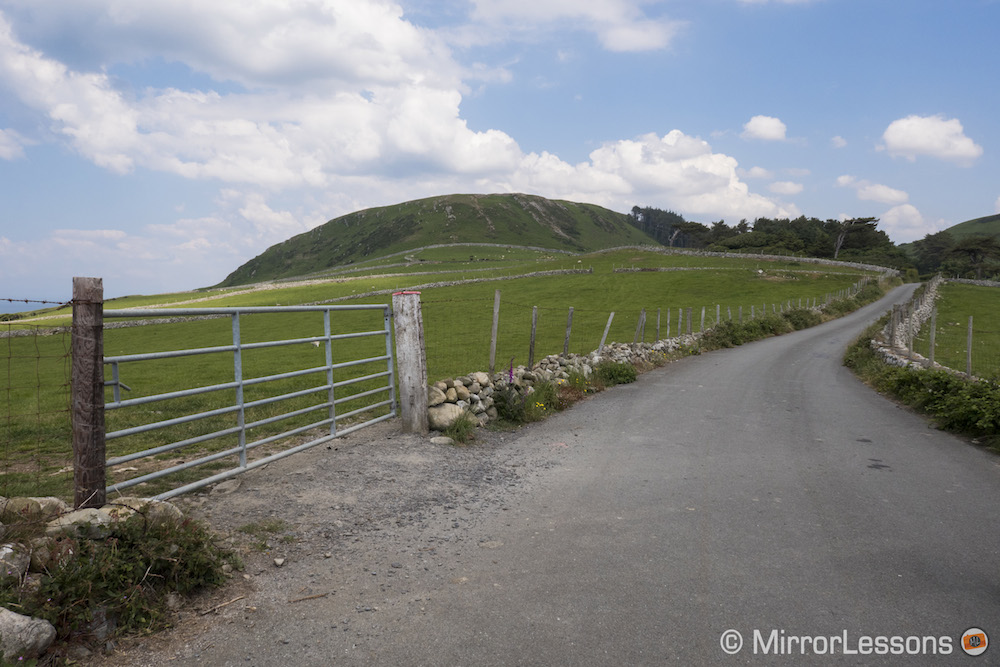 [/twentytwenty]
[/twentytwenty]
At the low ISOs (80 – 800), the camera renders detail very well. From 1600 up to 25600 ISO, both luminance and chroma noise become quite visible in the RAW files, the files lose some contrast, and the camera’s noise reduction algorithm kicks in. Even when set to 0, noise reduction can be quite aggressive, so you may want to reduce it within the Photo Style menu.
If I owned this camera, I’d probably only ever use it up to 3200 ISO but it is nice to know that the higher values are there if you need them.



I was quite impressed with the dynamic range of the sensor considering its size, though admittedly it is easier to recover details from the shadows than the highlights. When you open the shadows, there is some luminance and colour noise but not as much as you might expect.
- Slide to the right to see the unprocessed RAW file
- Slide to the left to see the post-processed RAW files (shadows and highlights recovered 100%)
[twentytwenty] 
 [/twentytwenty]
[/twentytwenty]
What I like – 4K Photo and other features
What I love about Panasonic as a company is that they don’t deprive their smaller cameras of all the latest goodies found on the high-end models.
Like all the latest interchangeable models, the TZ100 films in 4K at 30 or 25 fps at a bit rate of up to 100Mbps or in Full HD 1080p at 60 or 50 fps at a bit rate of up to 28Mbps. To create the 4K UHD frame, the camera performs a significant crop that reduces the field of view (37-370mm equivalent). This can be an advantage to gain some telephoto reach but problematic if you are after a wide field of view.
The ability to shoot in 4K opens up a world of possibilities, including access to many of Panasonic’s latest features such as:
4K Photo: With this function, you can grab 8MP JPGs from 4K footage shot at 30fps. It is a great asset for fast action or fleeting moments that are difficult to capture, such as image below showing two birds fighting for a place in the bird bath. By default, 4K Photo is accessible from the Function 1 button. (To find out more about 4K Photo, we invite you to read our in-depth article.)

4K Cropping: A relatively new 4K function that digitally pans or zooms by cropping the 4K footage to Full HD in-camera. We first tested this function on the Panasonic GX85, and you can see how it works in the video below.
Post Focus: The camera scans the scene for the closest and furthest focus points and takes a 4K video covering the distance between these two points. You can then choose the image with your preferred focus point from the footage and save it as an 8MP JPG. By default, Post Focus is accessible from the Function 2 button.
Light Composition: Captures a continuous 4K video stream but only ever adds new bright pixels to the composition. Good for fireworks, light painting or star trails but is somewhat limiting because it only produces an 8MP JPG.
In addition to the various 4K Photo features, there are also a number of other features worth trying such as:
Time Lapse Shot: Allows you to do interval photo shooting in-camera. Set the shooting interval (1 second to 99:59 minutes) and image count (1-9999).
Snap Video: Quickly record 2, 4, 6 or 8 second clips. Pull focus while recording and fade from monochrome to colour or vice versa.
Stop Motion Animation: Combine multiple still images to create a stop motion animation. You can choose between 4K (25/24p) and Full HD (50/25p) record quality in MP4 format.
Panorama: Merge a number of shots together to create a panorama. Only available as a JPG.

Multiple Exposure: Create a single image from multiple exposures.
Silent Shooting: Use the electronic shutter to shoot in complete silence. Works up to 1/16000s.
HDR: Takes multiple shots at different exposures and combines them in-camera. Only available if you turn off RAW picture quality in the menu.
In-camera RAW processing: Process an image in-camera. You can make adjustments to exposure, contrast, highlights, shadows, saturation, noise reduction, sharpness and more.
Digital Zoom: The digital zoom extends the range of the optical zoom to the equivalent of 1000mm. It crops the centre of the image, resulting in lower image quality and less resolution.
WiFi connectivity: Connect the camera to a wireless device such as a smartphone or tablet, control the camera from the device, or upload your images.
What I like – Battery life
I was pleasantly surprised by the battery life of the TZ100, which takes the same DMW-BLG10E battery used for the GX85 and LX100. After a full day of shooting stills and 4K video in the Lake District, there were still two bars left flashing on the battery level indicator.
Usually, I complain when companies fail to provide a separate charger with their cameras but in the case of the TZ100, it isn’t really necessary because the battery lasts so long. To charge the camera, I often used our Anker Charger, which we also use to charge our phones.
What hasn’t really changed – Autofocus
- Depth from Defocus contrast detection autofocus system
- AFS (single), AFC (continuous), AFF (flexible), MF (manual)
- Pinpoint, 1-Area, Custom Multi, 49-Area, Tracking and Face / Eye Detection
- Low (2fps), Medium (6fps), High (10fps) and Super High (50fps at reduced 10MP resolution)
The TZ100 has inherited Panasonic’s Depth from Defocus (DfD) contrast detection autofocus system and comes with the various autofocus modes found on the high-end models.

In AFS, we find that the DfD autofocus system works very well. As soon as you half-press the shutter button, the AF point locks right onto the subject with little to no hesitation, even in poor light.
Our experience with the system for moving subjects in AFC mode has been similar on all the latest Panasonic cameras we’ve tested: it works well but it isn’t at the same level as a phase detection autofocus system such as that of the Sony a6300. It is unreliable for fast-moving or unpredictable subjects and suffers a little in poor light conditions, but can deliver good results for slow to medium paced subjects in good light.

When I used the camera at a downhill bike race in Aberystwyth, I ended up with a very mixed bag of results. Sometimes the biker would be perfectly in focus for most of the burst, whereas other times, only one or two shots would be in focus. Quite frequently, it would focus on the background or bounce back and forth between the biker and the spectators.

Overall, my hit rate was around 50% regardless of whether I used the widest angle or zoomed in, which isn’t bad for a compact camera in this price range. The best results were always achieved with the Custom Multi AF mode as you can choose your own group of AF points. AF Tracking proved the least successful because the target would either fail to recognise the subject or refuse to follow it.

Keep in mind that the TZ100 has a Live View option that allows you to view your scene in real time and follow your subjects more easily. Even though it is only available up to 6fps, which is the maximum burst speed you can use in AFC anyway, it is reasonably fluid.

Also keep in mind that with a sensor this small and a slow aperture at the longest focal lengths, your depth of field will always be very deep so everything will appear in focus unless your subject is close to you.
What I don’t like – Electronic viewfinder
- built-in 0.2-inch EVF with 1,160K-dots of resolution
- 2.59x / 0.46x magnification
- 100% field of view
We’ve now come to the very small selection of features that didn’t particularly strike me during my time with the TZ100.
The first is the built-in electronic viewfinder. Now, don’t get me wrong; I love that camera companies are providing users with the option of an electronic viewfinder even on small compact cameras. They can be extremely handy in bright light or for certain genres such as sports. But the problem is that there is a limit on how large you can make a viewfinder on a camera that’s designed to be small and portable.

In the case of the TZ100, the 1166K-dot viewfinder is only 0.2 inches in size, making it one of the tiniest I’ve ever tested. Looking through it for too long can be a headache-inducing experience, so it’s best to use it only when absolutely necessary.
And size isn’t the only issue. I’ve also noticed that, in some conditions, the colours appear less natural through the viewfinder than on the LCD screen. Along with appearing more contrasty, the blues in particular can take on a florescent hue in certain light conditions. What’s more, reflections can occur within the viewfinder when there is a strong backlight.
Finally, the diopter seems to have a mind of its own. Whenever I go to use the viewfinder, I always find that the diopter has completely shifted position, so I have to waste time trying to recalibrate it.
I personally prefer the electronic viewfinder of the Sony RX100 III and IV. Being a pop-up EVF, Sony was able to make it a little larger than that of the TZ100. Still, neither is particularly enjoyable to use for extended periods.
What I don’t like – LCD screen
- 3-inch 1,040K-dot LCD
- touch-sensitive and fixed
The TZ100’s LCD monitor is central to the shooting experience. Not only does it let you preview your scene in real time but you can also use it to choose your autofocus point, take a picture, access the virtual function buttons, scroll through the menu or flip through your images in playback mode.
The biggest beef I have with the LCD isn’t the screen itself, which is just as good as Panasonic’s other touch sensitive screens, but the fact that it doesn’t tilt. Since starting this website, we have both grown incredibly accustomed to using tilting or articulating screens to shoot at angles that would otherwise be impossible without lying flat on the ground or renting a step ladder!
Perhaps this choice was made to keep the cost down or to preserve the camera’s tiny dimensions. Either way, it is a feature I sorely missed during our testing period.
What I don’t like – Limits on aperture and shutter speed
- 60s-1/2000s shutter speed or 1s-1/16000s with electronic shutter
- aperture range of f/2.8 – f/8
The final aspects that bothered us were the limits placed on the aperture and shutter speed range. While f/2.8 is a decent fast aperture, we were quite surprised that the slowest aperture available is f/8. This can be problematic in very bright conditions where the electronic viewfinder isn’t practical, such as a daytime sports event where there are lots of moving subjects. We imagine that this choice was made because diffraction occurs earlier on with smaller sensors, and including f/11 or f/16 would have resulted too much loss in image quality.
The mechanical shutter speed, too, is limited, topping out at 1/2000s which often isn’t enough in very bright conditions. That said, you can use the electronic shutter at up to 1/16000s for static subjects. Using these speeds with moving subjects can produce rolling shutter, and artificial lighting may result in banding.
Conclusion
Compact cameras with a 1-inch sensor like the Panasonic TZ100 are an excellent middle ground between the high-end performance and image quality of interchangeable lens cameras and the portability of smartphones and small point-and-shoots. At the suggested retail price of nearly $700, it is targeting a niche market of advanced amateurs and professionals looking for an alternative to their complete camera system for day-to-day and travel photography.

Coming from the Sony RX100 series, I sometimes found myself missing the faster aperture range of the RX100 III and IV not only for the extra shallow depth of field but also because I was able to keep my ISO values low in poor light. However, the devil’s advocate within me fully supports Panasonic’s decision to give the TZ100 that extra zoom range. The proof is in the photographs I took during the testing period: about half the time, I used a focal length longer than the equivalent of 100mm.
It is also impossible to fault the various extra features, most of which are linked to the camera’s 4K capabilities and can be found on Panasonic’s interchangeable lens models. I love that I can grab a quick 4K video and extract a shot from the footage, or change the focus point after I’ve taken the shot.
The only real disappointment was the electronic viewfinder, which I was only able to use briefly before my head started to ache, and the lack of a tilting LCD screen.
In short, the TZ100 is a welcome addition to the 1-inch sensor compact camera club and manages to fill a niche thanks to its flexible zoom range.
 What I like about the Panasonic TZ100 / ZS100:
What I like about the Panasonic TZ100 / ZS100:
- The versatility of the zoom range makes the camera a great all-in-one choice for a variety of photographic genres
- Has a very small, compact and light body
- Comes with loads of fun and useful features found on Panasonic’s high-end models including 4K video and photo options
- Great image quality, dynamic range and low-light performance for a small sensor
- Amazing optical and electronic stabilisation for stills and video
 What I don’t like about the Panasonic TZ100 / ZS100:
What I don’t like about the Panasonic TZ100 / ZS100:
- The electronic viewfinder is too small
- The LCD screen doesn’t tilt
- The limited aperture and shutter speed range is problematic in some conditions, such as very bright light
